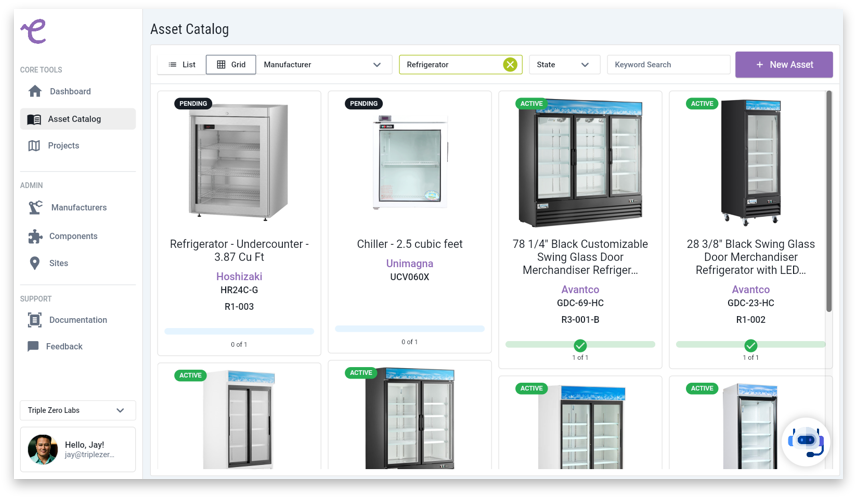Imagine your home is overflowing with clutter. You hire a professional organizer who tidies everything up—but without proper shelves and storage, the clean items just end up in a neat pile on the floor. That’s what happens when you rely solely on AI to clean up your asset data, especially when managing furniture, fixtures, and equipment (FF&E) for owner-furnished items in repeatable commercial spaces.
Here are the top three reasons why AI isn’t a magic fix—and why you need a solid platform to organize your cleaned AI data:
1. Cleaned Data Needs a Home

AI can scrub your asset data from PDFs such as drawings, product data sheets, installation manuals, and more, much like a professional organizer tidies up your kid’s playroom. But without a robust platform to house that clean data, you’re left with information floating in digital limbo.
For large-scale enterprises, relying on spreadsheets just doesn’t cut it. They simply can’t handle the complexity or scale needed to manage FF&E across thousands of locations. At a minimum you’ll want to implement a database and file repository, but then you’ll need to find someone to manage it all.
2. Context Is Everything

Imagine your kitchen when hosting a dinner party. Every tool, ingredient, and appliance has its designated spot, and everything needs to flow together perfectly. In asset management, a robust data platform works the same way—it ensures that product specifications, procurement details, maintenance histories, and other essential components all have their proper place and are connected seamlessly.
Without these relationships, or at the very least an asset identification system, your asset data is like a disorganized kitchen where the fridge, pantry, and utensils are scattered in different rooms, making it impossible to cook up efficiency.
3. Sustainable Processes Require a Strong Foundation

Imagine trying to keep your home tidy without any proper storage—no closets, shelves, or labeled bins. No matter how often you clean, the clutter just keeps coming back.
For large organizations, a consistent set of data standards is like having a custom storage system in every room. It not only keeps everything in its proper place but also enables you to automate repetitive tasks and analyze big data for strategic insights. Without that solid foundation, even the smartest AI cleanup is just a temporary fix on a constantly disorganized mess.
Introducing Ephany, an asset management platform which sparks joy.

At Ephany, we’re tackling these challenges head-on. We don’t just clean your data—we give it a home. Our solution leverages smart AI to import and polish data from PDFs (like product data sheets, installation manuals, and project details) while securely organizing it on a robust platform designed for large-scale enterprises managing FF&E for owner-furnished items. We even connect your teams to the Revit Families which include the standardized asset data that they need for projects.
By creating meaningful relationships between components, parts, and procurement details, Ephany transforms isolated data into powerful insights that drive efficiency and reduce costs.
Ready to turn your digital clutter into a well-organized powerhouse? Reach out for a free demo and discover how Ephany can streamline your asset management process.
About the Author

- Jay is a seasoned BIM manager with over 20 years of experience across design and construction firms. Most recently as Sr. BIM Manager at Amazon, he focused on establishing processes and standards to simplify furniture, fixture, and equipment (FF&E) asset management for repeatable design (physical retail).
Latest entries
 Industry KnowledgeMarch 13, 2025Common Issues with Retail FF&E and How to Mitigate Them – Part One
Industry KnowledgeMarch 13, 2025Common Issues with Retail FF&E and How to Mitigate Them – Part One Industry KnowledgeMarch 1, 2025McDonaldization and Construction: How Owner-Furnished Items Unlock Scalability
Industry KnowledgeMarch 1, 2025McDonaldization and Construction: How Owner-Furnished Items Unlock Scalability Industry KnowledgeFebruary 10, 2025Decluttering Your Data: Why AI Alone Won’t Solve the Mess
Industry KnowledgeFebruary 10, 2025Decluttering Your Data: Why AI Alone Won’t Solve the Mess Industry KnowledgeJanuary 28, 2025Lean Out Your BIM Processes by Reducing Asset Information in Your Models
Industry KnowledgeJanuary 28, 2025Lean Out Your BIM Processes by Reducing Asset Information in Your Models

